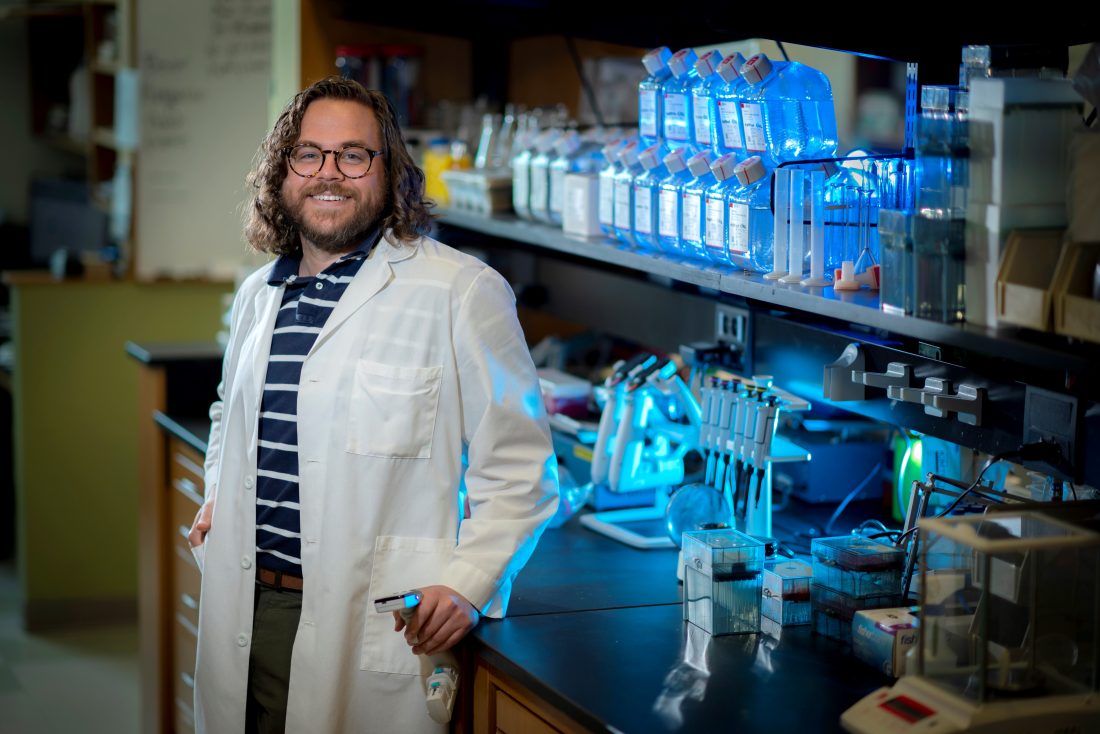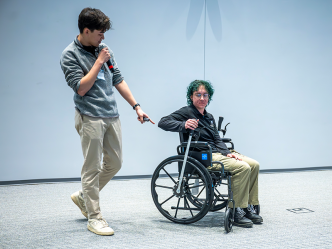T-cells, immune cells that normally protect us, appear to play a key role in the development of preeclampsia, says a young scientist who wants to find a better way to intervene in the syndrome that can have lifelong consequences for mother and child.
These key immune cells appear to contribute to a vicious circle in which the placenta does not develop an adequate thoroughfare for mother’s blood, which is packed with essential nutrients and oxygen, to reach her baby. Mother’s blood pressure increases to try to force more of the essentials through; inflammation and tissue damage develop; and T cells move in to help. But the immune cells instead multiply the inflammation, blood vessel dysfunction and resulting kidney damage in the mother and increase the risk of premature birth or worse for baby.
“Everything should be in balance and what I think is happening in preeclampsia is we are moving more toward the proinflammatory, prooxidative stress side of things. It’s full on the gas, no brake involved,” says Dr. John Henry Dasinger, senior postdoctoral fellow in the Department of Physiology at the Medical College of Georgia at Augusta University.
In this scenario, the typically protective T cells recruit even more T cells which produce even more reactive oxygen species, or ROS, in their likely well-intended effort to clean up the mess. ROS, a byproduct of the body’s use of oxygen that at low levels serves as an important signaling mechanism for cells, is toxic at high levels and in preeclampsia Dasinger has evidence T cells are producing a lot of ROS.
Blood vessels further constrict, and production of the powerful blood vessel dilator nitric oxide goes down in this “recipe for disaster,” Dasinger says. “Somehow if we could blunt their response, that could be helpful,” Dasinger says of where his findings point.
Right now, there is a rather long list of risk factors for preeclampsia, that includes things like the mother already being hypertensive and/or obese, but no definitive test to determine which women will develop it and better treatment is needed for those who do.
Dasinger, who works with Dr. David Mattson, an established hypertension investigator who chairs the physiology department, has been awarded a K99/ROO program award (K99HL157549-01A1) from the National Heart, Lung and Blood Institute of the National Institutes of Health. The Pathway to Independence Award, is selectively awarded as postdocs begin their transition toward becoming a successful, independent faculty member. Dasinger has been awarded a total of $205,088 over the next two years for the K99 portion. He will secure $253,073 each of the following three years to help enable a successful transition to faculty status through the ROO portion.
Dasinger has a great model to study preeclampsia from its outset in the Dahl Salt Sensitive rats, a widely used research model that readily develops high blood pressure on a high-salt diet. But he and his colleagues have found that about half these rodents spontaneously develop preeclampsia on a low-salt diet, so, unlike other study models, which require surgical or pharmacological intervention, the spontaneity enables the scientists to look at preeclampsia from its start and to do comparative studies as well.
With the new grant, Dasinger is testing his hypothesis that in preeclampsia T cells that move into the placenta and kidneys from the mother are producing enough ROS to be problematic and increase the preeclampsia risk.
He is looking to further test the hypothesis of the contribution of T cells by a novel technique of transferring both normal T cells and T cells that can’t produce ROS to see what happens in his preeclampsia model. This will also help answer questions like whether in preeclampsia the T cells, for some reason, already are activated or if they get that way because of challenges like inadequate blood flow.
He suspects the T cells go bad in response to what is happening and has some evidence that the T cells he is transferring that can produce ROS will, and that they will again exacerbate the unhealthy vicious cycle.
In their lab animals, for example, preeclampsia results in a 25-30% mortality rate for the mother by the second pregnancy that goes up to greater than 50 % mortality by the third pregnancy. But rats that don’t have T cells or can’t generate ROS survive three pregnancies, another pretty clear message that T cells and ROS are essential to the damage and death associated with preeclampsia. You can’t take T cells out of people, but again something that dampens the response could lessen the impact of the syndrome, Dasinger says.
As he looks further at vascular dysfunction, he’s finding a decrease in the mother’s natural ability to form and dilate blood vessels. That vascular dysfunction during pregnancy is likely at least part of what also sets mother up for cardiovascular problems later in life, when she gets stressed again, and part of what he also is studying. “If there is some kind of vascular dysfunction during pregnancy, that is not just going to go away,” he says.
During pregnancy, small, so-called spiral arteries, that form from the uterus into the developing fetus, are supposed to become large, low-resistance vessels that enable sufficient supplies to meet the demands of the growing baby. But the vessels don’t properly expand in size or number, which is widely considered the initiating step. The mother increasing her pressure to try and compensate is next.
“It’s a highly vascularized organ because it’s a barrier between the mom’s side and the fetal side so if it’s not properly vascularized, that could lead to problems for both mother and baby,” notes Dasinger.
He’s also further exploring the kidney dysfunction that occurs and the mother’s increased lifelong risk of chronic kidney disease and death that may result. Chronic kidney disease can both result from and exacerbate problems with high blood pressure and increase the rate of related problems like stroke, and potentially require a lifetime on dialysis and/or a kidney transplant.
“Everything comes from mom,’ Dasinger says, so the mother’s kidneys work harder and get slightly larger normally in pregnancy to also support the baby. In preeclampsia their effort is further heightened by having to work against higher blood pressure as the mother experiences a surge in blood pressure, which may already have been high, and there is often protein in her urine, a sign of kidney damage. “That is why it’s a syndrome, because so much is happening,” Dasinger says.
The model Dasinger is using also is a stronger model particularly for studying preeclampsia’s impact in Black mothers, who are disproportionately impacted by both salt-sensitive hypertension and preeclampsia. It also enables longer term studies of the health of the mother, including changes in kidney function with subsequent pregnancies, as well as the impact on baby at birth.
As a PhD student at the University of Mississippi Medical Center in Jackson, Dasinger’s focus was more on the cardiovascular consequences to the baby later in life. Preeclampsia typically shortens the length of the pregnancy and babies tend to be born smaller, he says. He saw the offspring of rodent models of the common condition develop hypertension earlier in their life than their normal, birthweight counterparts, and males had increased rates of earlier mortality.
While his focus is now more on the mother, where the problems start, he thinks his work will circle back to the baby’s health as well.
Why the babies too have lifelong increased risk of cardiovascular problems, for example, remains uncertain, but some like Dasinger postulate their major organs, already challenged during development by decreased supplies of vital nutrients and oxygen, likely are more vulnerable to stressors that occur later in life, like hypertension and obesity.
The MCG team, led by Mattson, reported last year in the journals ACTA PHYSIOLOGICA and Pregnancy Hypertension: An International Journal of Women’s Cardiovascular Health that a plant-based diet appeared to protect the rats that were bred to become hypertensive on a high salt diet from hypertension. It also showed a whole grain diet protected mother and baby from preeclampsia.
Other risk factors for preeclampsia include the mother having diabetes, a family history of preeclampsia, fertility treatment, being over age 35, being Black and/or developing preeclampsia during a previous pregnancy.
 Augusta University
Augusta University




